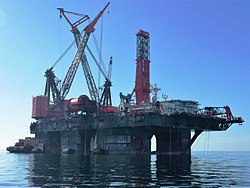Balder (ship)
|
Balder at work near Trinidad
|
||||||||||||||
|
||||||||||||||
|
||||||||||||||
|
||||||||||||||
|
||||||||||||||
|
||||||||||||||
|
||||||||||||||
The Balder is a crane and work ship built in 1978. The ship was built by the Japanese Mitsui Engineering & Shipbuilding Company, part of the Mitsui Group . Like its sister ship Hermod, the ship belongs to the Dutch company Heerema Marine Contractors (HMC) and is mainly used for the construction of offshore structures and the laying of pipelines . The ship is also known as the DCV Balder ; DCV stands for D eepwater C onstruction V essel (deep-sea work ship ) and Balder is the god of light in Germanic mythology .
History and structure
The ship was originally built as semi-diving crane vessel (SSCV, S emi S ubmersile C rane V nettle) constructed, but in 2001 by the Dutch rebuilt shipyard Verolme Botlek (now Keppel Verolme) in a deep-sea working ship. A class III dynamic positioning system (DP system) was also installed during the renovation . At the time of their design, Hermod and Balder were groundbreaking for many successor designs due to their structure and performance and revolutionized shipbuilding for work ships.
The hull of the Balder consists of two floats, each connected to the deck structure via three pillars. The draft, which is around 12 meters (m) at the overpass, will be lowered to around 28 m during the work in order to reduce the effects of waves and surface currents.
The ship has two cranes with a capacity of 3600 and 2700 tons (t) and can therefore lift heavy loads of up to 6300 t in tandem with a radius of 33.5 m. The larger of the two cranes can lower a load of 360 t to a depth of 3000 m.
It is driven by two electrically driven controllable pitch propellers with an output of 4400 kilowatts (kW) each, which are installed in a short nozzle. Seven jet propulsion systems of the type LIPS FS3500-571 / NU have an output of 3,500 kW each. The six jet propulsion systems of the DP system are powered by six diesel generators each with an output of 4,000 kW (5,000 kVA). Power is supplied by six diesel generators with 2765 kW each.
In 2001 the largest laying thread for mooring lines in the world (English Mooring Line Deployment Winch, MLD-Winch for short), with a diameter of 10.5 m, was installed. It can be used to set up anchorages up to a water depth of 3500 m. In 2002 a 98 m high J-Lay tower was installed on the port side , with which it is possible to lay pipelines up to 3000 m deep.
To anchor the ship, there are twelve “Delta Flipper” anchors weighing 22.5 t, which are attached to 4500 m long steel cables with a minimum breaking strength of 386 t.
The ship offered heated and air-conditioned cabins for 367 people until January 2007. With the following renovation, the capacity increased to 392 people. The helicopter deck is able to accommodate helicopters up to the size of a Sikorsky S-61 .
Technical specifications
Dimensions:
- Deck width: 105.5 m
- Draft: 11.5 - 28.2 m
Cranes:
- Crane 1:
- maximum capacity: 3600 t
- maximum lifting height: 116 m
- Crane 2:
- maximum capacity: 2700 t
- maximum lifting height: 98 m
Others:
- Load capacity of the deck: 20 t per m 2
- Total load-bearing capacity of the deck: 8,000 t
- Ballast pump capacity: 8,000 m 3 per hour
- Dynamic ballast absorption: 500 t per second
- Cruising speed: 6.5 knots with a payload of 8,000 t on deck and a draft of 11.5 m
Big projects and records
- The Balder held the record for laying pipelines. In 2005, parts of a pipeline were laid at a depth of 2200 m as part of the Mardi Gras project. The pipeline was connected directly to the Thunder Horse . It broke the record of the Saipem 7000 , which had laid a pipeline in the Black Sea at a depth of 2,150 m for the Blue Stream project . The Balder record was broken by the Solitaire , the world's largest pipelayer, who laid a pipeline at a depth of 2,775 m.
- In 2005, the Thunder Horse , the largest anchored, semi-submersible oil platform in the world, was installed with the Balder . It also helped raise the platform from its incline, which almost overturned due to Hurricane Dennis .
- 2007 anchored Balder the Independence Hub facility , a distribution platform, m in a record depth of 2,438 (8000 ft). "Suction piles", a special type of pile foundation , were set at a record depth of 2,438 m. The project also installed the well return line at a record depth of 2,743 m (9,000 ft).
Web links
Footnotes
- ↑ Information on the reconstruction of the Balder on the Gusto website (English, accessed on April 7, 2009) ( page no longer available , search in web archives ) Info: The link was automatically marked as defective. Please check the link according to the instructions and then remove this notice.
- ↑ Report in Offshore Magazine about the Mardi Gras project (accessed on March 22, 2009)
- ↑ Marinebuzz with information on Solitaire (accessed on May 28, 2010)
- ↑ Rigzone with information on installing the Independence Hub Facility . Retrieved December 19, 2010.

